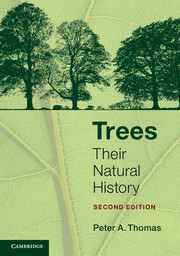Book contents
- Frontmatter
- Epigraph
- Contents
- Preface
- Chapter 1 An overview
- Chapter 2 Leaves: the food producers
- Chapter 3 The trunk and branches: more than a connecting drainpipe
- Chapter 4 Roots: the hidden tree
- Chapter 5 Towards the next generation: flowers, fruits and seeds
- Chapter 6 The growing tree
- Chapter 7 The shape of trees
- Chapter 8 The next generation: new trees from old
- Chapter 9 Age, health, damage and death: living in a hostile world
- Chapter 10 Trees and us
- Further Reading
- Index
- References
Chapter 3 - The trunk and branches: more than a connecting drainpipe
Published online by Cambridge University Press: 05 July 2014
- Frontmatter
- Epigraph
- Contents
- Preface
- Chapter 1 An overview
- Chapter 2 Leaves: the food producers
- Chapter 3 The trunk and branches: more than a connecting drainpipe
- Chapter 4 Roots: the hidden tree
- Chapter 5 Towards the next generation: flowers, fruits and seeds
- Chapter 6 The growing tree
- Chapter 7 The shape of trees
- Chapter 8 The next generation: new trees from old
- Chapter 9 Age, health, damage and death: living in a hostile world
- Chapter 10 Trees and us
- Further Reading
- Index
- References
Summary
The woody skeleton
What makes a tree different from other plants is the trunk (or bole) and branches making up the woody skeleton. The main job of this tough, long-lasting skeleton is to display the leaves up high above other lesser plants in the battle for light. As well as support, though, the trunk and branches have two other important jobs: getting water from the roots to the leaves and moving food around the tree to keep all parts, including the roots, alive. But is the trunk just a large connecting drainpipe that keeps the two ends of the trees apart? In many senses ‘yes’ but its structure allows it to do many other things that no mere drainpipe could do.
Starting from the outside is the outer bark, a waterproof layer, over the inner bark or phloem (Figure 3.1). The phloem is made up of living tissue that transports the sugary sap from the leaves to the rest of the tree. Inside the bark is the cambium which, as will be shown, is responsible for the tree getting fatter. Inside this again is the wood proper or xylem. Although seemingly ‘solid wood’ it is the part of the tree responsible for carrying water from the roots to the rest of the tree. The water moves upwards through dead empty cells. But wood is not entirely dead. Running from the centre of the tree are rays of living tissue (made up of thin-walled ‘parenchyma’ cells) which reach out into the bark (and in some trees there are lines of these living cells running up through the wood as well). As will be seen later these living cells are involved with movement and storage of food and the creation of heartwood, the dense central core of wood that (reputedly) supports the tree as it becomes larger. At the very centre of the tree, some trees, but not all, have a core of pith (the strengthening tissue when the shoot was very young and soft).
- Type
- Chapter
- Information
- TreesTheir Natural History, pp. 51 - 101Publisher: Cambridge University PressPrint publication year: 2014



